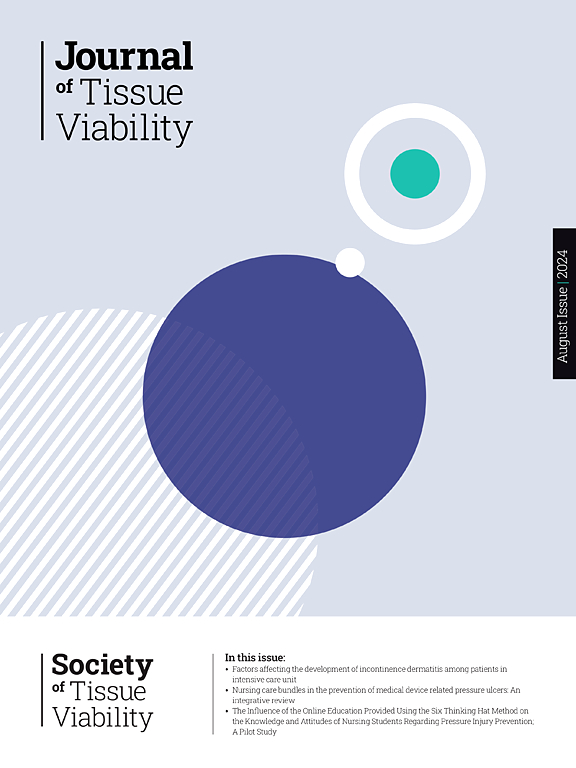比较不同的现代伤口敷料对野生型小鼠和 2 型糖尿病 db/db 小鼠全厚皮肤伤口愈合的影响。
IF 2.4
3区 医学
Q2 DERMATOLOGY
引用次数: 0
摘要
背景:为了评估皮肤伤口愈合的过程,人们进行了各种实验。然而,迄今为止,什么样的现代伤口敷料是合适的仍不清楚。因此,本研究旨在比较不同现代伤口敷料的愈合过程,以确定它们是否适用于实验性急性伤口和慢性糖尿病伤口:对 12 只 C57BL/6J 小鼠和 11 只 db/db 小鼠进行全厚伤口损伤。小鼠被分为以下四组:野生型小鼠和 db/db 小鼠的水胶体组、表格组、薄膜组和纱布组。伤口愈合评估持续到第 14 天:结果:在野生型组中,所有伤口在第 14 天时都已愈合并完成了再上皮化。但是,野生型-form 组和野生型-gauze 组的伤口表面干燥,伤口周围过度收缩。在 db/db 组中,伤口直到第 14 天才愈合。db/db-水胶体组的伤口渗出物较多,并逐渐增多,直至第 14 天。db/db-薄膜组的伤口渗出物一直存在到第 14 天。相反,在 db/db-form 组和 db/db-gauze 组,伤口表面干燥,伤口周围过度收缩:这些结果表明,水胶体和薄膜敷料是适用于小鼠急性伤口和慢性糖尿病伤口模型的现代伤口敷料。此外,根据糖尿病皮肤伤口愈合研究的目的,使用水胶体或薄膜敷料都是必要的。本文章由计算机程序翻译,如有差异,请以英文原文为准。
Comparison of different modern wound dressings on full-thickness murine cutaneous wound healing with wild-type and type-2 diabetes db/db mice
Background
To evaluate the process of cutaneous wound healing, experiments have been conducted. However, to date, what modern wound dressings are suitable remains unclear. Therefore, this study aimed to compare the healing process in different modern wound dressings to determine their suitability in experimental acute wound and chronic diabetic wound.
Materials and methods
Twelve C57BL/6J mice and eleven db/db mice were subjected to full-thickness wound injuries. The mice were divided into the following four groups: hydrocolloid, form, film, and gauze groups in both wild-type and db/db mice. Wound healing was assessed until day 14.
Results
In the wild-type groups, all wounds were healed and completed re-epithelialization by day 14. However, the wound surface was dry, and the periwound was hypercontracted in the wild-type–form and wild-type–gauze groups. In the db/db groups, wounds were not healed until day 14. Wound exudates in the db/db-hydrocolloid group were abundant and gradually increased until day 14. Wound exudates in the db/db-film group were present until day 14. Conversely, in the db/db-form and db/db-gauze groups, the wound surface was dry, and the periwound was hypercontracted.
Conclusion
These results showed that hydrocolloid and film dressings are suitable modern wound dressings for the mice wound models of acute wound and chronic diabetic wound. Moreover, using either hydrocolloid or film dressing depending on the purpose of the study on cutaneous wound healing in diabetes is necessary.
求助全文
通过发布文献求助,成功后即可免费获取论文全文。
去求助
来源期刊

Journal of tissue viability
DERMATOLOGY-NURSING
CiteScore
3.80
自引率
16.00%
发文量
110
审稿时长
>12 weeks
期刊介绍:
The Journal of Tissue Viability is the official publication of the Tissue Viability Society and is a quarterly journal concerned with all aspects of the occurrence and treatment of wounds, ulcers and pressure sores including patient care, pain, nutrition, wound healing, research, prevention, mobility, social problems and management.
The Journal particularly encourages papers covering skin and skin wounds but will consider articles that discuss injury in any tissue. Articles that stress the multi-professional nature of tissue viability are especially welcome. We seek to encourage new authors as well as well-established contributors to the field - one aim of the journal is to enable all participants in tissue viability to share information with colleagues.
 求助内容:
求助内容: 应助结果提醒方式:
应助结果提醒方式:


